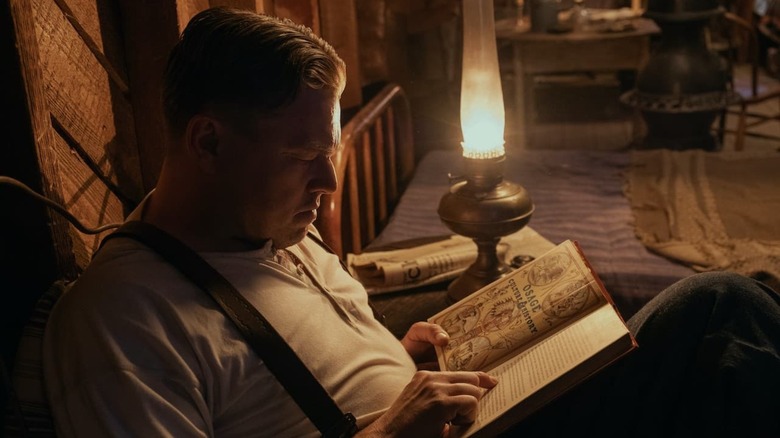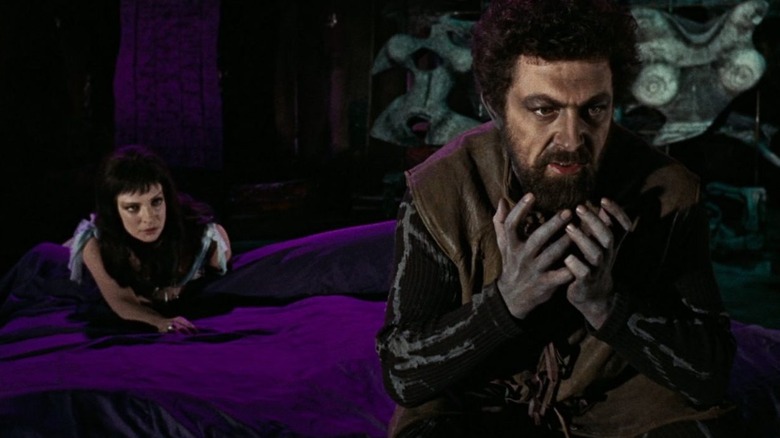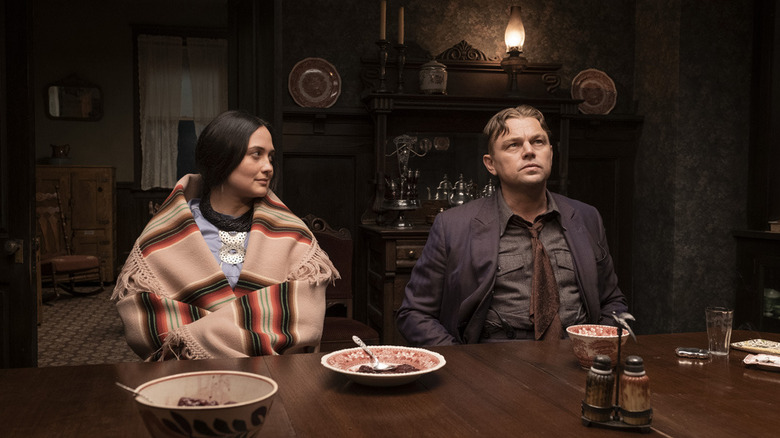Killers Of The Flower Moon Borrowed A Key Element From A Very Unlikely Movie
Martin Scorsese and his longtime editor Thelma Schoonmaker have seen more movies than you. Both of them have long been champions of independent and international cinema, and they have each done their part to amplify titles and filmmakers that might be lost in the sea of the commercial American film market. When they're not making movies, they're likely overseeing the restorations of lost classics or recommending great movies you've never heard of on Turner Classic Movies. But they're also constantly incorporating nods and tips of the cap to those films in their own work.
Schoonmaker was in a relationship with celebrated British filmmaker Michael Powell, the co-director (with Emeric Pressburger) of such classics as "The Life and Death of Colonel Blimp," "I Know Where I'm Going!," "Black Narcissus," and "The Red Shoes." Their romance spanned a decade, starting in 1980 and sadly ending in 1990 when Powell died. In a recent interview with Little White Lies, Schoonmaker talked about the BFI's current retrospective on Powell and Pressburger's movies and what went into restoring it. When Powell died, he asked Schoonmaker to be the executor of his body of work, and she has looked after it with the greatest of care. The retrospective includes Powell's more famous classics, of course, but also some of his lesser-seen works. Notably, the retrospective includes a restoration of Powell's 1964 film "Bluebeard's Castle" a.k.a. "Herzog Blaubarts Burg," a filmed version of the opera by Béla Bartók and Béla Balázs.
Although the original opera was sung in Hungarian, Powell decided to stage "Bluebeard's Castle" in German. Anyone who has been lucky enough to see that movie will note that it only has a few English subtitles (which Powell translated himself). Schoonmaker revealed that a lack of subtitles in "Bluebeard's Castle" was a large part of what gave Martin Scorsese the impetus to have multiple scenes in "Killers of the Flower Moon" presented in the Osage language without subtitles.
Bluebeard's Castle
When asked why Powell decided not to present "Bluebeard's Castle" with subtitles, Schoonmaker admitted she wasn't entirely sure. She noted it might have merely been a budgetary restriction, as Powell directed the film for German television, which wasn't terribly well-moneyed at the time. She said:
"I'm still conflicted about whether possibly it was just a monetary issue to not have subtitles, but I don't think so. From what Michael told me he wanted people to watch the film and not read subtitles, because of course in opera there'd been tons of them. He decided that he would just give them a little bit of a summary of what's happening so they can get the emotion from the music and the performance."
It seems that impulse is what also led Scorsese to leave subtitles off of "Killers of the Flower Moon." The new film is set in the Osage Nation in the early 1920s, and Lily Gladstone plays an Osage woman who marries a former soldier and rising low-level criminal played by Leonardo DiCaprio. Gladstone's character has diabetes, and she takes injections of a new miracle drug called insulin. Because of the nature of the movie's plot, she begins to suspect that there might be something in her needle besides insulin.
When the two characters come to blows over the injections, they argue in the Osage language. There are no subtitles for these sequences. "[Powell's decision] inspired Marty when we were working on 'Killers of the Flower Moon,'" Schoonamker said. "A great portion of it is in Osage, and he decided not to have subtitles in certain places."
The scene in question
Schoonmaker recalls the insulin scene in particular as being inspired by "Bluebeard's Castle." She recalled:
"There's an argument between DiCaprio and Lily Gladstone, and you get the idea that she's upset about the doctor giving her a shot because she doesn't trust them, but there are no subtitles in that scene. The actors were trained to speak Osage and Lily did it so well that the trainer said she sounded like her mother. She's phenomenal. And so Marty said no subtitles here. So that was something that Michael was feeling, particularly with opera. Where you really want to see the singer emote as well as sing beautifully. It's a radical idea."
Indeed, for a generation, films had no sound, and drama was communicated through body language and facial expressions. Actual dialogue wouldn't become a concern in cinema until about 1927. Knowing exactly what actors are saying, Schoonmaker notes, isn't vital to understanding how they feel or what's happening in a scene. Osage speakers will know exactly what's going on, but non-Osage speakers will certainly not be lost.
Some actors may have engaged in the improv practice of acting out a scene wherein all their words must be presented as gibberish, not even relying on a known language to communicate. I am reminded of international pop stars who would sing English-like nonsense ... to some pretty impressive results.
For Schoonmaker and Scorsese, one of their creative inspirations came from a German opera film. It's a good reminder that ideas can come from anywhere.


